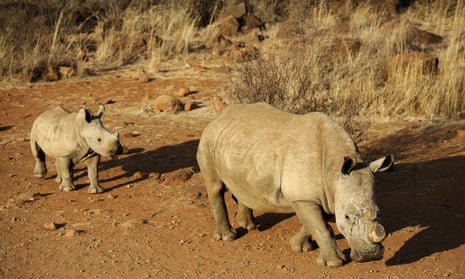Efforts to curb the deadly trade in rhino horn appear to be gaining traction, with a poll finding that demand for the animal part in Vietnam has dropped by more than a third over the past year.
After a year-long public information campaign in Vietnam, only 2.6% of people in the Asian country now continue to buy and use rhino horn, a decrease of 38%.
Importantly, there has been a 25% decrease in the number of people who think rhino horn, which is made of the same material as fingernails and hair, has medicinal value. However, 38% of Vietnamese still think it can treat diseases such as cancer and rheumatism.
The polling was conducted by Nielsen for the Humane Society International (HSI) and the Vietnam Convention on International Trade in Endangered Species of Wild Fauna and Flora (Cites).
Vietnam is a key market for the trade of rhino horn, which prompted the awareness campaign to try to deter people from buying and consuming it.
Demand for rhino horn, primarily in China and south-east Asia, is putting severe pressure on rhino numbers in Africa. Last year a record 1,004 rhinos were illegally poached in South Africa, which has more rhinos than any other country. Another 821 have been killed this year.
This explosion in poaching is relatively recent – only 13 rhinos were poached in South Africa in 2007. A key reason for this is the soaring price of rhino horn: it can reach $100,000 a kilogram on the black market, rivalling the price of cocaine and gold.
The public information campaign has focused on dispelling the myth that rhino horn has medicinal value. The campaign has been centred on Hanoi, Vietnam’s capital, through business, university, school and women’s groups.
Advertisements have appeared on buses and billboards, and an HSI book called I’m a Little Rhino has been distributed in schools.
The drive has been supported by other international efforts. Businesswoman Lynn Johnson, an Australian with no previous conservation experience, recently raised money to launch a series of advertisements in Vietnam that warn people rhino horn is harmful to them and is a bad choice as a status symbol.
“The messaging has gone up significantly in Vietnam over the past year which is fantastic,” Johnson said. “Our campaign targets the users directly but overall the amount of information aimed at Vietnamese has increased markedly.”
Teresa Telecky, director of wildlife at HSI, said it is crucial to reduce demand for rhino horn.
“These poll results demonstrate that, even in a relatively short period of time, our demand reduction campaign has succeeded in significantly and dramatically altering public perception and influenced behaviour,” she said. “The results offer a vital ray of hope for the survival of rhinos.”
Do Quang Tung, director of the Vietnam CITES management authority, said: “The demand for rhino horns by just a small proportion of people in Vietnam has not only damaged the position of Vietnam in international forums but also leveraged the poaching of rhinos.”

Comments (…)
Sign in or create your Guardian account to join the discussion